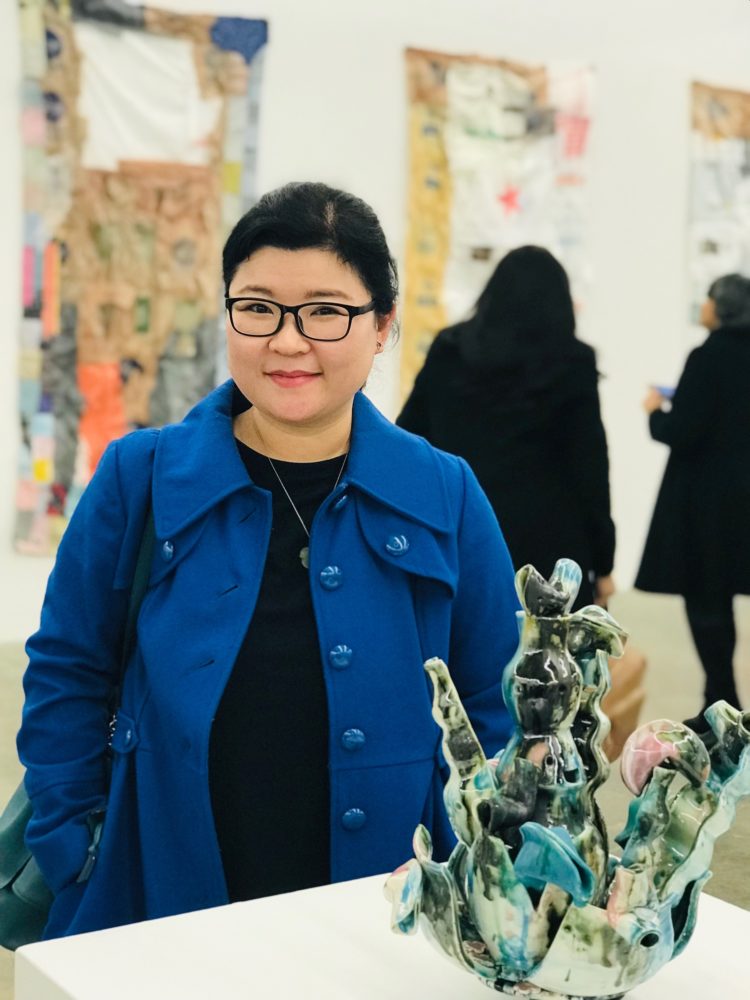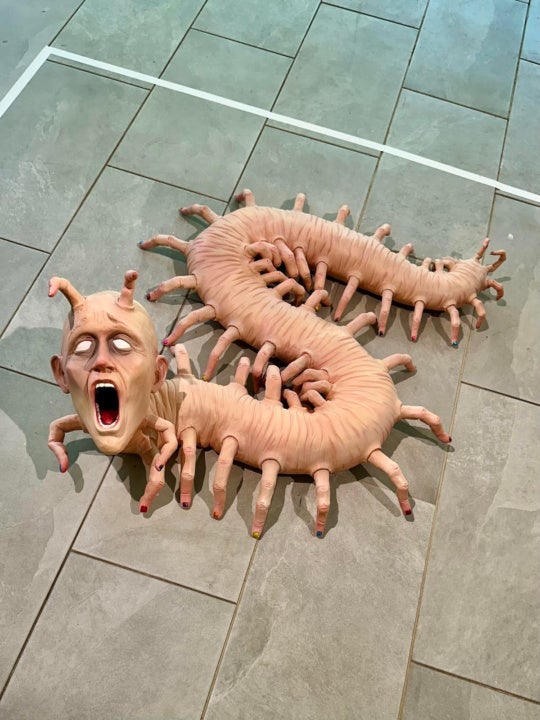
Before meeting with Chamblee resident and artist Jiha Moon at Mozart Bakery off of Buford Highway, I visited Atlanta Contemporary on a quiet evening to see her work on view at the 2019 Atlanta Biennial. I found the experience to be so intimately engaging and curious. Perhaps everyone should view artwork as if they were going to have a cup of coffee with the artist afterwards. I was most struck by Moon’s work Nabi Gaksi, which sounds beautiful even in translation: “Butterfly Bride.”
When on display like this, the mask acts as a mirror—not necessarily in the way that the mask might reflect the viewer, but in how the viewer reflects the mask. Because the mask appears as a work of art as much as it remains a recognizable and familiar object, viewers can approach it more empathetically, hoping to peek into a different world, or perhaps letting themselves hide for a while.
My conversation with Jiha Moon was conducted in person in January 2019 and has been edited for publication.

Onyew Kim: I want to talk about the imagery of the banana that appears in your work in the Atlanta Biennial. For Asian-Americans, being called a banana means you’re “yellow” on the outside, “white” on the inside. In relation to living in the American South and how others perceive you, do you see yourself as a banana?
Jiha Moon: The banana is interesting because it’s Andy Warhol’s banana, but I’m using it in such a different context. I know that’s a little naughty, and I like it. People might recognize the banana without understanding the cultural implication of it, but I don’t mind. Misunderstanding is a step towards understanding. It helps you dig deeper. This misunderstanding is indicative of the way people might reduce me to a banana. We are always trying to categorize ourselves and others. I try not to let that affect how I see myself as an individual.
OK: There are several traditional elements that conflict with contemporary images that represent a reduction of culture in your work. It’s not only in the imagery, but also in the materials you use. Can you speak more to this feeling of discord?
JM: I feel like my life is like a collage, and I’m a piece of it. I cut and pasted myself from Korea to America. I use tradition as a point of departure, but I don’t want my work to be about an idea. I want it to become something completely new. Tradition is history set in place, but culture is always shifting. I like to juxtapose these two to create a dialogue. I want them to be harmonized as well as individually recognized. Working with multiple mediums helps to achieve visually stark contrasts while creating a unifying piece. I am having so much fun making art objects. Going from being a painter to working across multiple mediums has freed me as an artist. Right now, I’m having the most fun experimenting with masks.

OK: I particularly connected with the mask on display at Atlanta Contemporary. There’s a sense of intimacy in looking at a mask that I think is perhaps more difficult to access in other art forms. Do you believe that masks grant the wearer the ability to see into different worlds?
JM: Yes. Masks have the power of disguise. You can perform behind a mask. The wearer has the agency. I like working with masks right now because it gives the viewer an instant connection. It’s so approachable. You can experience the fantasy. I think looking at art should feel like you are experiencing the artist’s fantasy, and masks give that to you.
OK: I think your overuse of fortune cookies is so witty. The fortune cookie is interesting, in some ways, because it was invented in America. What is the purpose of having it recur so often in your work?
JM: Yeah, it was first made in a Japanese restaurant in California to attract more Western customers. It’s funny how culture gets started and transferred. Sometimes we don’t actually know what belongs to whom. At first, people in China didn’t even know that the fortune cookie was “Chinese.” The fortune cookie is an American artifact, or an American monster. It is American consumption of a reductive Asian culture. I don’t like my work to be pigeon-holed and categorized as “Asian art” because that’s not necessarily what my art is. I am also American, as is the fortune cookie. So the fortune cookie is kind of poking fun at those who unwittingly look at my art as if it’s authentic to my Korean heritage.
Jiha tells me that she likes being mischievous and playful in her artwork. After over two hours of discussing her work, social media, generational and cultural gaps, and her role as honoree at this year’s Art Crush, she tells me to ask her about something completely different.
OK: What’s your favorite food?
JM: You know, I love Korean food, but I also really love fusion food. The subject of food is interesting to me because it actually relates back to my work. There’s a Korean soup called budae-jjigae, which is a product of the Korean War. The history is that Koreans made soup with ramen noodles along with the spam and sausages that American soldiers left behind. Same thing with banh mi, which is also a product of war and imperialism. It’s a French baguette and marinated pork. So, from two vastly differing cultures, a completely new and unique dish was created. Food talk is really exciting for me. It’s also an act of creating and consuming, but participation is necessary for survival.
Works by Jiha Moon remain on view as part of A thousand tomorrows, the 2019 Atlanta Biennial at Atlanta Contemporary, through April 7.
Moon is the honoree of this year’s edition of Art Crush, BURNAWAY‘s signature, annual fundraiser. Find out more about this year’s event—which includes a silent auction, interactive installations, live printmaking, and more— and purchase your tickets here.




